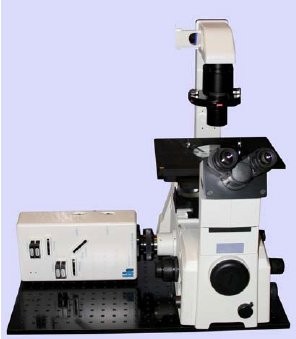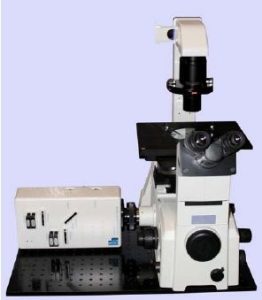The DCS-120 MP uses non-descanned detection to reach a high penetration depth for multiphoton excitation. The MP system is available with inverted Nikon, Zeiss, and Olympus microscopes. Due to its fast beam scanning and high sensitivity, the DCS-120 system is compatible with live-cell imaging.
DCS-120 functions include simultaneous recording of FLIM in 2 fully parallel wavelength channels, laser wavelength multiplexing, time-series FLIM, time-series recording, Z stack FLIM, phosphorescence lifetime imaging (PLIM), fluorescence lifetime-transient scanning (FLITS) and FCS recording.
Applications focus on lifetime variations by interactions of fluorophores with their molecular environment. Typical applications are ion concentration measurement, FRET experiments, metabolic imaging, imaging of fast physiological effects, and plant physiology.
DCS-120 MP Multiphoton FLIM systems are available with titanium-sapphire, and femtosecond fibre lasers. Ti:Sa-laser systems have the advantage of tuneability and high laser power. The high power allows the use of an AOM (acousto-optical modulator) for software-controlled intensity regulation, fast beam blanking, and pixel-synchronous on-off modulation for simultaneous FLIM /PLIM. Fibre-laser systems, on the other hand, are compact, easy to use, and virtually maintenance-free. But, the wavelength is typically fixed 780 nm. This lack of tuneability is less of a problem than commonly believed: The two-photon-absorption bands of most fluorophores are broad enough to excite them at this wavelength. Moreover, 780 nm is an excellent wavelength to excite NADH. Fibre laser systems therefore make almost ideal multiphoton metabolic-FLIM systems.
Main Features:
- Complete multi-photon FLIM Systems, including microscope and lasers
- Multiphoton FLIM upgrades for existing conventional microscopes
- Excitation by Ti:Sa or femtosecond fibre laser
- Combined multiphoton/confocal systems available
- Laser control integrated into system software
- Excitation wavelengths from 650 nm to 1200 nm
- Scanning by fast galvanometer mirrors
- Two non-descanned detection channels
- Suppression of scattering and stray light
- Channel separation by dichroic or polarising beamsplitters
- Individually selectable pinholes and filters
- Recording by BH’s multidimensional TCSPC process
- Two fully parallel TCSPC FLIM channels
- Time channel width down to 203 fs
- Ultra-fast and ultra-sensitive detectors
- Unprecedented time resolution
- Detection of lifetimes <10 ps
- Near-ideal photon efficiency
- Excellent lifetime reproducibility
- Fast online-FLIM
- Megapixel FLIM, 2048 x 2048 pixels
- Precision FLIM, 4096 time channels
- Mosaic FLIM
- Z Stack FLIM
- Accumulation of fast time series
- Excitation wavelength multiplexing
- Multi-wavelength FLIM
- Simultaneous FLIM/PLIM
- Integrated motorized sample stage
- Data analysis by bh SPCImage NG
- Ultra-fast processing by GPU
- Combination of time-domain analysis and Phasor plot
- Image segmentation by Phasor plot or 2D histograms
- MLE Fit of decay curves
- Automatic IRF modelling
- No need to record IRF
Molecular Imaging with FLIM
Fluorescence Correlation – FCS
Simultaneous metabolic Imaging and pO2 imaging
Cellular and tissue fluorescence
In-vivo FLIM of Skin
Multiwavelength FLIM
Simultaneous FLIM/PLIM








